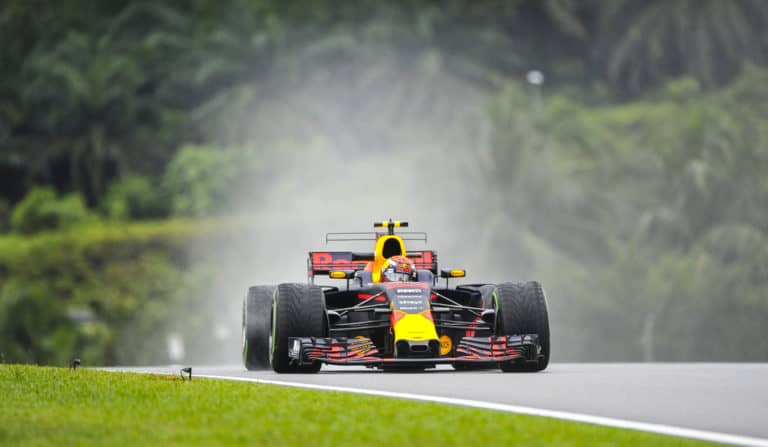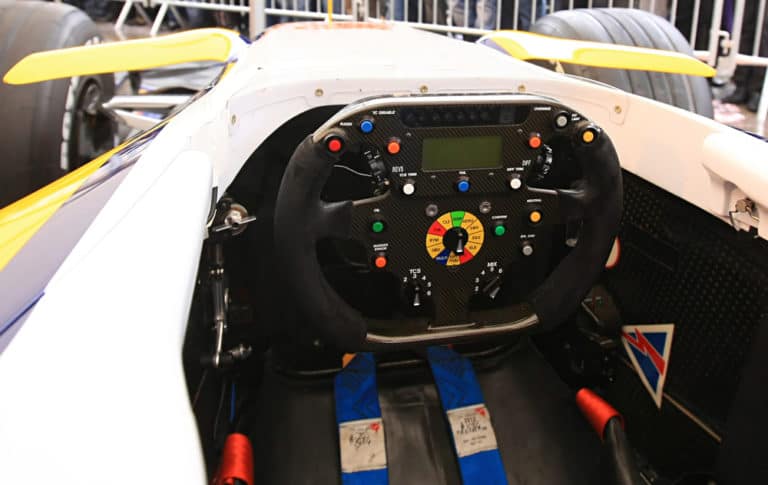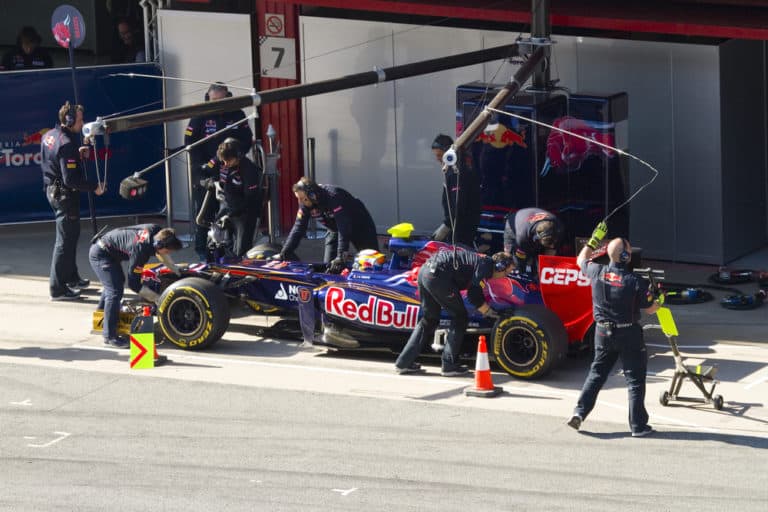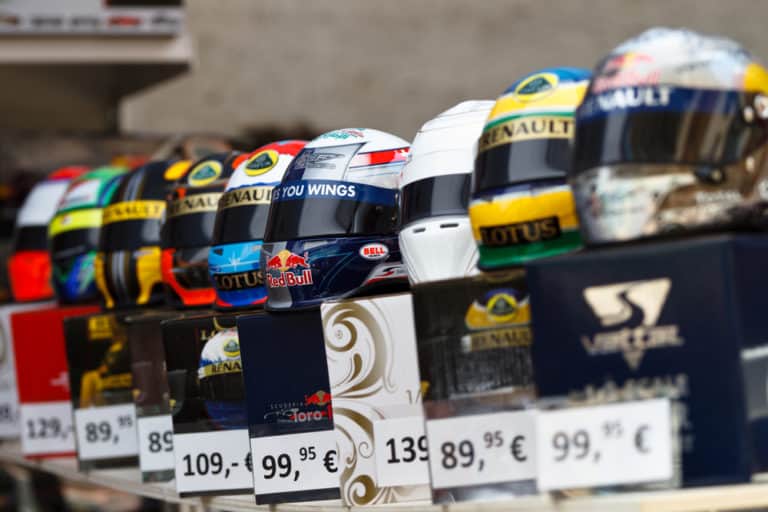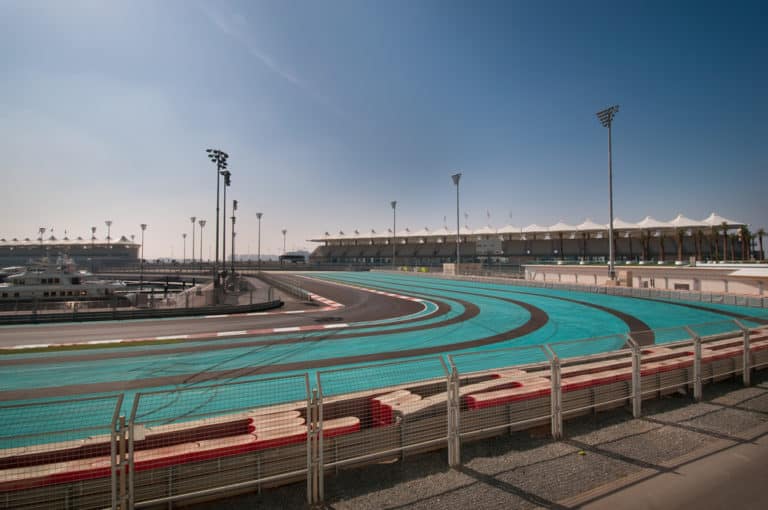Image: Shutterstock.com
Have you ever watched Lewis Hamilton speed around the track in his powerful Mercedes F1 car and thought to yourself that you wouldn’t mind one of those for your Sunday drive? Well, with a few significant adjustments, that dream could become a reality, as it is actually possible to convert an F1 car into a road car.
It would take a lot of changes to an F1 car to drive it on the road. In fact, it has already been legally done, but there is only one car of its kind in the world. The main changes that had to be made were related to the height, engine, and suspension, as well as some basic additions to make it road legal.
It would take a lot to drive an F1 car on the road. This has been done already. The engineers of the Mastercard Lola Formula 1 team were challenged to make a roadworthy F1 car. With some massive changes and a different engine, they were able to pull it off, and they called their invention the F1R. In this article, we’ll investigate how they did this and look at some other examples of F1 cars driving on public roads. So, read on to find out what it would take to drive an F1 car on the road.
What Is The Background To The Building Of The F1R?
Lola was an F1 team in 1997 that failed to get off the ground. They were founded by Eric Broadley, who had always wanted to own an F1 team, and he managed to get Mastercard on board as their title sponsor.
However, they failed to even get onto the starting grid at the opening race of the season in Australia in 1997. This is because, during qualifying, they were 13 seconds behind everyone else.
As a result of this disastrous start to the season, Mastercard withdrew their sponsorship, which left the team bankrupt. This meant that they could not even ship the cars or the equipment to the next race at Interlagos in Brazil.
The team then withdrew from F1 with a large amount of debt and had to be bought out to stay afloat.
However, the spare car parts still existed, and something had to be done with them. The Lola engineers were challenged to try to make a legal, roadworthy Formula 1 car and what you’re about to read about is the result. They used many of the old spare parts from Formula 1 to create the body of the car and a lot of other parts of the car.
This meant that the car they ended up making was a legal car made up of old F1 car spare parts with an engine and gearbox from road cars.
How Did They Build This Road-Legal F1 Car?
Building the F1R was quite a complicated process as it wasn’t just adding brake lights and indicators to an already built F1 car. Instead, they started from scratch and used the bodywork and a few other components of the F1 car and then added everything necessary to make it legal.
F1 cars do not have high suspension, which means that everyday things on the road like speedbumps will pose an issue for the car’s undercarriage. Therefore, the first thing the engineers did was to raise the suspension to about two inches, which is approximately 5cm. This can be raised by a few centimeters if need be.
Unfortunately, the engine is not nearly as powerful as the standard F1 engines these days, so don’t expect to be taking on Hamilton and co on the track. The engine is a 2.0-liter four-cylinder Cosworth engine and comes from a Ford RS Sierra.
It is meant to deliver around 370 hp, which is at least 630 hp less than current F1 cars, although it is supposedly possible to tweak the turbo to adjust the horsepower. But even then, you will still have significantly less than an F1 car, which means that even George Russell and Nicholas Latifi will be far ahead of you on the track.
But that doesn’t really matter, because it’ll still look cooler than all your friends’ cars.
Unfortunately, the gearbox does also not come from an F1 car but don’t worry; it still comes from a sports car. They replaced the semi-automatic gearbox with a five-speed manual Porsche G50 transaxle.
Furthermore, the former Lola engineers also had to add some simple features to make the car legal. Indicators/turn signals, a regular steering wheel (you can remove it like an F1 steering wheel, though), a handbrake, and headlights. It also comes with a registered UK number plate.
However, there are still many original F1 parts that have been used for the car. It has the FIA standard nose cone, the ducts and body panels, carbon brakes, a cooling kit, and some other parts.
It also looks quite a lot like an F1 car as it is complete with the front and rear wings that distinguish F1 cars from others. These wings are adjustable and help produce downforce, increasing your speed, just like a standard F1 car.
Here is summary of what was changed and what wasn’t and how the F1R differs from an actual F1 Car.
| Part Name | Actual Lola F1 Car | F1R built by Lola Engineers |
| Engine | 1997 F1 V8 3.0-liter Engine | 2.0-liter Cosworth Engine |
| Gearbox | Semi-automatic 1997 F1 gearbox | G50 five-speed manual Porsche transaxle gearbox |
| Chassis | Lola Chassis | Lola Chassis |
| Tub and Body Panels | Lola Parts | Lola Parts |
| Front and Back Wings | Lola Parts | Lola Parts |
| Suspension Height | Front: 1.18 inches Back: 2.9 inches (Measurements taken from a modern F1 car). | 1.9-2.9 inches |
| Indicators / Turn Signals, Handbrake, Brake Lights & Headlights. | N/A | Present |

Can I Buy The F1R And How Much Will It Cost?
That isn’t exactly clear right now, as nothing has been reported online since the car was listed for sale in 2016.
It was being auctioned by a luxury auction house, Bonhams, for between £ 55,000 – 85,000, which right now is about $75000 – 117000. At the time of sale, it only had 25 miles on the clock, which meant it was almost as good as new.
You can view the listing from Bonhams here.
How Can I Build My Own F1 Car For the Roads?
The answer to this is pretty complicated for several reasons. The most obvious one is that of getting legitimate Formula 1 parts. But let’s say you do. You will have to modify most of the car to ensure that it is within the legal requirements.
You’ll also have to change the suspension, add all the basic features like brake lights and indicators, and probably modify the engine.
It’d also be a good idea to consult closely with your local motor authority, as the rules and regulations for vehicles are pretty complicated and are a very long read.
It would also cost you much more money than the price of the F1R that Bonhams are auctioning.
What About Proper F1 Cars, Can They Drive On Public Roads?
The answer here is yes, but also no. They can drive on normal, well-maintained roads with relative ease. In fact, some races, such as those in Monaco and Baku, Azerbaijan, are held on street circuits, rather than proper racetracks like most Grand Prix’s.
You may have also seen some of Red Bull Racing’s promotional videos where they took some of their older F1 cars all around the world and, in fact, on public roads. They did a road-trip through Max Verstappen’s home country of the Netherlands and a race through Istanbul to promote the Alpha Tauri clothing brand.
However, these were planned events with lots of logistical management and no doubt involved lengthy consultations with local authorities. This was rather obvious as they were the only cars on the roads and were being followed by a large camera crew. Therefore, while technically on a public road, it was not a realistic scenario as there were no pedestrians or traffic present.
Furthermore, F1 often does street events worldwide in cities that don’t host F1 races to promote the brand. The way this is done is that one or two streets in a city will be closed off for a few hours, and some F1 drivers will drive up and down and so some doughnuts in front of the crowd.
Therefore, current F1 cars do not have to be modified to drive on public roads. However, they cannot legally do so outside of non-planned events because they are not in line with the standard roadworthy specifications.
Conclusion
If you wanted to do it legally and use it as an everyday car, it would take a lot to drive an F1 car on the road. You’d have to raise the suspension, add everything that normal cars have, like brake lights, headlights, and turn signals. You would probably also have to change the engine, so it’d be a costly exercise.
However, it’d be much cheaper than an actual F1 car, so you could say it is worth it.


